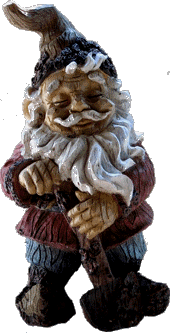Soil Issues and Soil Considerations

The Growing Medium
Fertile, well drained soil is necessary for a successful garden. The exact type of soil is not as important as that it be quick draining, well supplied with organic matter, reasonably free of stones, and moisture retentive. The subsoil also is very important. Hard shale, rock ledges, gravel beds, deep sand, or hardpan under the surface may make the development of garden soil extremely difficult or impossible.
Fertilizing with Chemicals
On the other hand, infertile soil that has good physical properties (tilth) can be made productive by using compost, organic matter, lime, commercial fertilizer, and other soil improving materials. If your garden has already been cultivated and used in past years, there is little to do other than to plow in additional organic material, and fertilizers. The fertilizer may be in the form of composted manure or any good commercial plant food distributed at a rate of 3 or 4 pounds for every thousand square feet of garden. Infertile soil will often benefit from even larger proportions of chemical fertilization, but care must be taken not to add too much because of the danger of fertilizer burn.
Your garden should not be plowed or worked while it is very wet unless the work will certainly be followed by severe freezing weather. If the soil sticks together in a ball and does not readily crumble under slight pressure by the thumb and finger, it is too wet for plowing or working, because in this condition it will cake as it dries, making it unsuitable for young plants.
Enhance your Soil Fertility with Compost
Composting has been going on since the beginning of time. Each year, Mother Nature produces foliage in the spring. In the autumn months, when the leaves fall from the trees, and annual plants die back, they begin the process of composting. In a year, or maybe two, this decayed plant matter becomes the food for a new plant or tree. This is composting in it's most basic form... When manure is added to the soil, it must be composted prior to planting, because fresh, hot manure will also burn your plants.
Course sand or perlite can be added to improve the drainage of the soil Adding sawdust, composted oak leaves, wood chips, peat moss, cottonseed meal, and leaf mold will help to condition the soil as well as lowering the soil pH.
Hardwood ashes, bone meal, crushed marble, and crushed oyster shells will raise your pH. If you are growing acid loving plants such as Rhododendrons, Azaleas or Heathers the mix should contain additional peat moss. (Different types of require varying degrees of soil acidity.)
pH is the measure of your soil's acidity
Basically soil pH is a measure of the amount of lime (calcium) contained in your soil, and as a result, the type of soil that you have. Generally, soils in moist climates tend to be acid and those in dry climates are alkaline. A soil with a pH lower than 7.0 is an acid soil and one with a pH higher than 7.0 is alkaline. If it is not already within required range, your soil will need be adjusted to suit the plants that will occupy the area.
Testing your soil pH
After the site has been prepared, and the soil and conditioners mixed, watered well and settled should you test the pH of the soil. The tested soil should be dry. Most good garden centers will even gladly pH test a soil sample for you, or you can buy an inexpensive pH test kit at most nurseries, or hardware stores.
These test kits generally consist of a test tube, some testing solution and a color chart. You put a sample of your soil in the tube, add a few drops of test solution, shake it up and leave it for an hour or so to settle. The solution in the tube changes color according to the pH of your soil. Compare the color of the sample with the color chart that came with the kit. Matching colors will tell you the pH of your sample. The better kits will also advisory booklets about how to interpret your result.
If the soil test reveals that you need to make corrections to your soil pH, you can use materials commonly available at your local garden center. If your soil needs to be more acidic, sulfur may be used to lower the pH. For raising the pH, lime is most commonly used. The amount of either material used will depend on the amount of change you need to make. The recommendations provided on the product label will help you determine how much to use.
A general rule of thumb is to add 4 lbs. of lime per 100 sq. ft. of garden for every pH point below 6.5, or 1 lb. of sulfur per 100 sq. ft. for every pH point above 7.5. The best way to adjust pH is gradually, over several seasons. Most garden vegetables do best on soils that are slightly acid and may be injured by the application of excess lime. For this reason lime should be applied only when tests show it to be necessary. If the soil is excessively alkaline, you may find that you are better off to build a raised bed using topsoil purchased from a nursery.